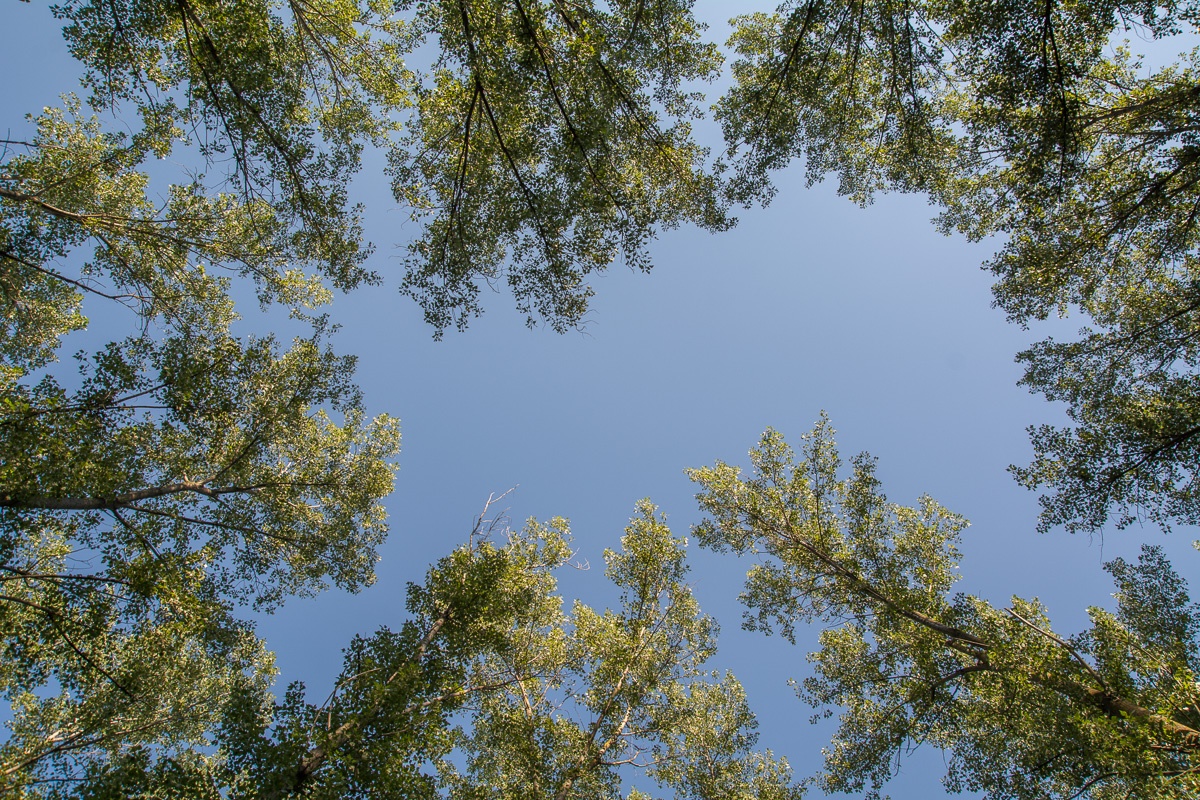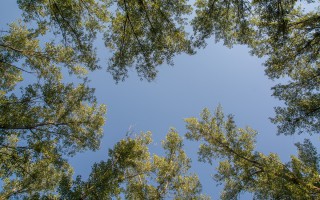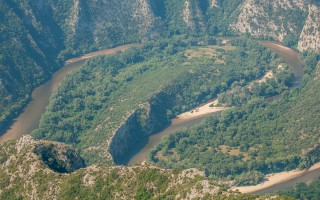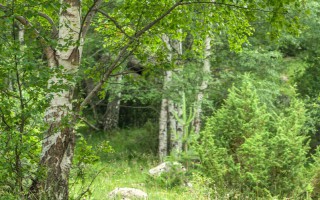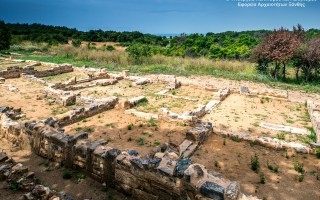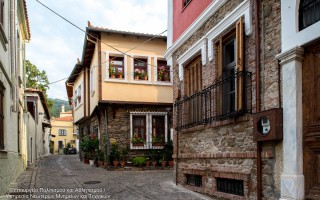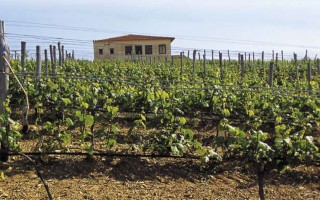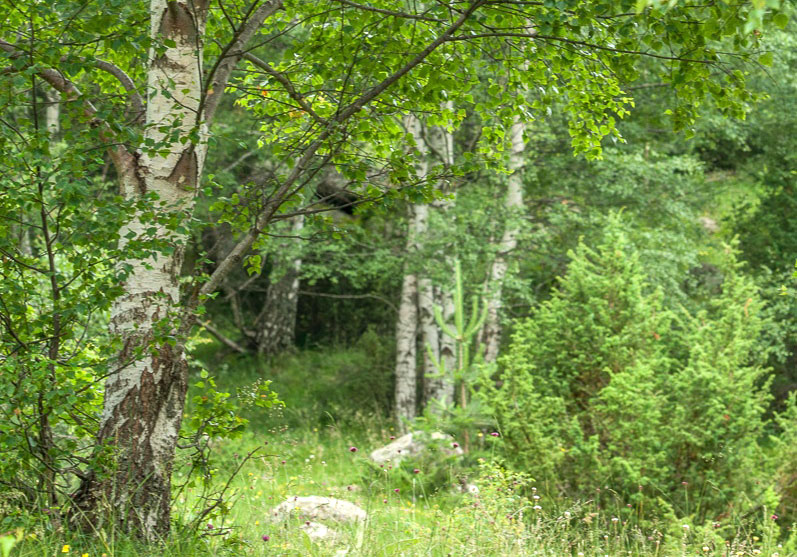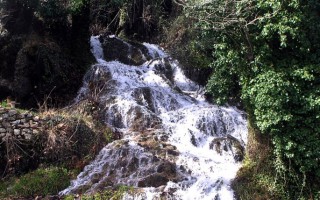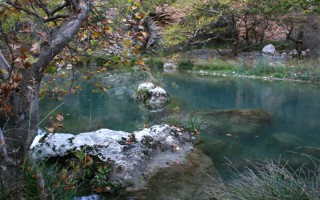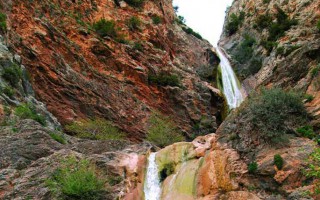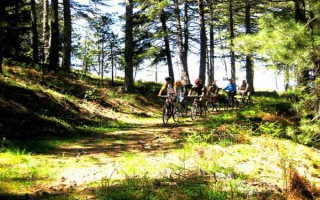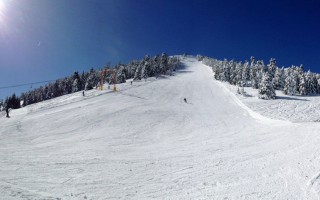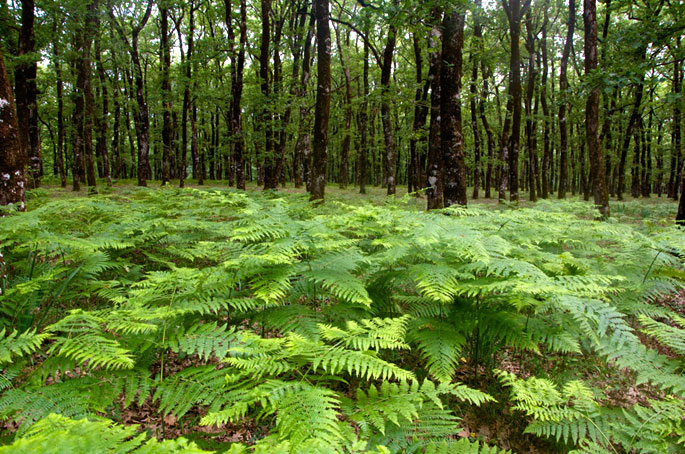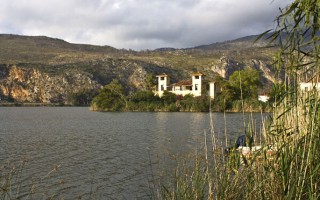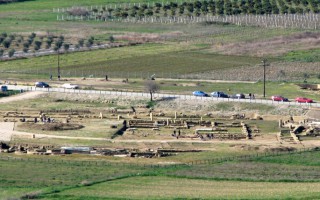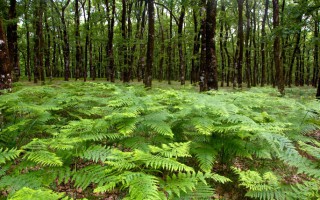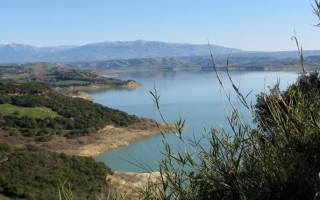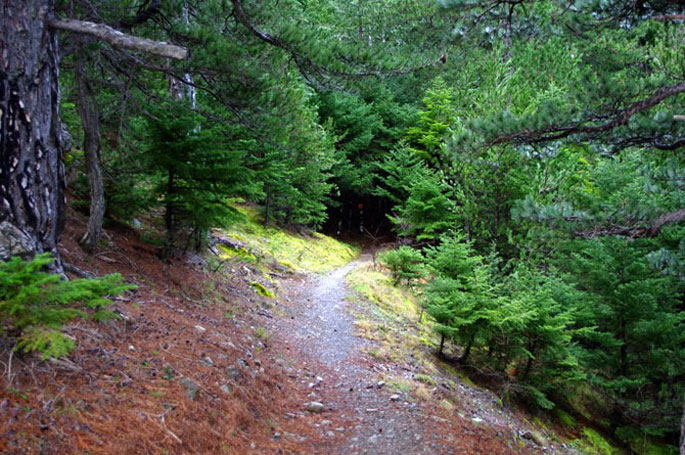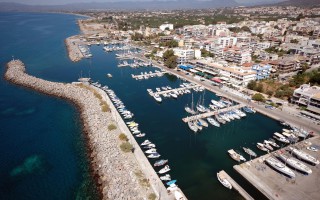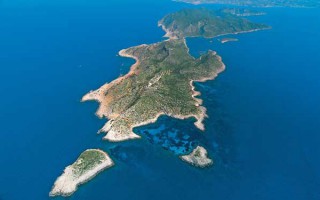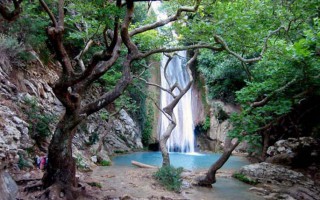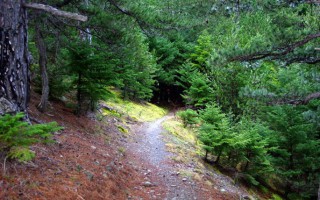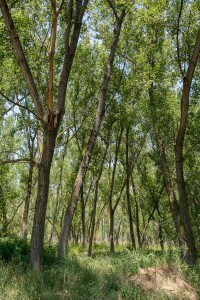 The riparian forest Kotza Orman or Large Forest isa priceless landscape of ecological value and beauty. It was once one of the largest aquatic of Europe, since the “50s there had been recorded 74,000 acres.
The riparian forest Kotza Orman or Large Forest isa priceless landscape of ecological value and beauty. It was once one of the largest aquatic of Europe, since the “50s there had been recorded 74,000 acres.
However,in 1946, 54,000 acres were out of it and given to farmers for cultivation, leaving a small part, which the Forest Service of Kavala is trying to preserve by fencing perimeter stretches of land and prohibiting any human activity.
The plants are dominated by willows, the alders, oaks, elms, factions and creepers (the Agrambeli, hops, ivy, etc.). Several species of wildlife are recording such as wild boar, jackal, fox, deer, hare, badger and the only wild pheasant population of kolchikos pheasant in Europe. The Forest Service in an area of about 15,000 acres cultivated poplars, targeting both in timber production and in the regeneration of the natural riparian forest.
Source: Eastern Macedonia & Thrace
Drama is gifted with rich woodland. In the sierra of Central Rodopi distinguished the forests of Elatia or Kara Dere, in Sidironero district – Skalotis. The place is located in the central and northern part of the county and extends along the Greek-Bulgarian border.
Forests cover 37% of the total area of the county and Elatia Forest is the largest forest complex in the country. The rare fir with red trunk (red spruce) grows up only here at an altitude of 1200m. lower Downy will meet with Leaved Oak, while higher is the zone of Beech, the Black Pine and Fir. The forest village is a base from which they can be made trips to Stravorema and to the neighboring beautiful forest, where inside a wonderful environment roll gurgling icy waters allowing everyone to enjoy the wonderful feeling of direct contact with nature. (NESTOS – MESTA 001) The fir forest located in the central and northern part of the county and extends along the Greek-Bulgarian border. Characterized by a forest cover of 90% and the existence of the village of Elatia. In place Koutras and in distance of 72km from Drama there is unique beauty”s spruce forest and in the surrounding area of Elatia in a place called Magoula there is a birch forest. Other tree species found are beech, scots pine, hornbeam etc., and there is a multitude of herbaceous plants, and mushrooms.
Generally, the flora in Elatias is rich of species (more than 700), with many rare for Greek area. The fauna of the area is also rich in species such as the brown bear, wild boar, elk, deer, wolves and many species of birds, eg eagles and hawks.
Source: Eastern Macedonia & Thrace
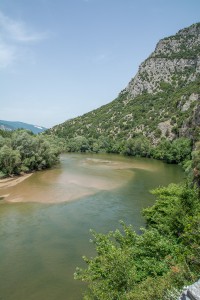 It is located at the borders of Kavala and Xanthi prefectures, south of the town of Stavroupoli, with area of 2,380 hectares. It is one of the most beautiful landscapes of Greece with great ecological interest. The visitors can see the plurality of rare plants such as the agriopaschalia, champerlea, red peony and ramnis of Rhodope.
It is located at the borders of Kavala and Xanthi prefectures, south of the town of Stavroupoli, with area of 2,380 hectares. It is one of the most beautiful landscapes of Greece with great ecological interest. The visitors can see the plurality of rare plants such as the agriopaschalia, champerlea, red peony and ramnis of Rhodope.
At the same time, the region is rich in fauna, with nesting wolves, wild cats – which are an endangered species – otters, ferrets, and rare birds such as the black stork, the vulture, the Alkyon, the brown goose and the pygmy cormorant.
Through the Straits of the river passes the railway line that connects Thessaloniki with the cities of Thrace, following an enchanting landscape. But apart from the train there is an etched path, which starts from the village of Galanis and reaches the Stavroupoli and Livaditi.
Source: Eastern Macedonia & Thrace
 In the Rhodope Mountains, on the border with Bulgaria, there is the Drimos Forest, also known as Chaidou. The forest Chaidou is an earthly paradise with huge centennial beech of over 30 meters height. Apart from the beech forest there is also a large variety of vegetation that grows in the mountains of Rhodope, such as pines, firs, spruces and yellow lilies.
In the Rhodope Mountains, on the border with Bulgaria, there is the Drimos Forest, also known as Chaidou. The forest Chaidou is an earthly paradise with huge centennial beech of over 30 meters height. Apart from the beech forest there is also a large variety of vegetation that grows in the mountains of Rhodope, such as pines, firs, spruces and yellow lilies.
It is also a habitat of bears, wolves and deers. In the 80’s the 180 acres of forest was declared “Natural Monument” and protected area. It can be seen several endemic plants of Rhodope, and other rare species of flora of Greece. There are also rare species of mammals and birds.
In Chaidou threre are bare fields and meadows and bare mountain slopes. Many streams and small rivers flow with fast and cold waters that constitute the zone of trout. It is a centuries-old beech forest, an area of 18 hectares and is located in the mountain Chaidou in the Central Rhodope Mountains, north of the city of Xanthi.
Source: Eastern Macedonia & Thrace
 Parnonas also known as “Malevos” is the mountain range which divides two large counties of Peloponnese, Arcadia and Laconia. The highest peak of Parnonas is called “Megali Tourla” also known as “Kronio” and has 1936 meters altitude. The mountain ends in Laconia at the Cape Maleas, south of Peloponnese.
Parnonas also known as “Malevos” is the mountain range which divides two large counties of Peloponnese, Arcadia and Laconia. The highest peak of Parnonas is called “Megali Tourla” also known as “Kronio” and has 1936 meters altitude. The mountain ends in Laconia at the Cape Maleas, south of Peloponnese.
The natural beauty of the mountain and the traditional villages attract many travelers throughout the year. The best time to visit the area is during the spring season when the snow melts and forms small waterfalls. There are many signposted hiking routes which allow the visitor to admire the gorges, the caves, the waterfalls, the springs and the rivers of this amazing mountain. Climbers will love the challenge of reaching the top of the mountain. “Megali Tourla” (1936m altitude) can be reached through a large path which crosses an amazing gorge. In the beautiful villages of Parnonas you will find places where you can rent mountain bikes or four-wheel drives to explore the amazing locations of this mountain.
Parnonas has five gorges (Loulougas, Mazias, Zarbanitsas, Spilakion, Lepidas) where rare species of flowers blossom. Mazias gorge is the easiest for hiking whereas the Lepidas gorge is very demanding and you will need special equipment and knowledge to cross it.
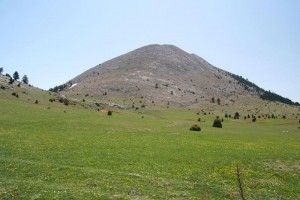 The name Parnonas existed already since the ancient period and the name meant “the ridge which shines”. During the ancient times the mountain was also called “Kronion” because it was considered to be the sacred mountain of Cronus, who was the leader of the Titans.
The name Parnonas existed already since the ancient period and the name meant “the ridge which shines”. During the ancient times the mountain was also called “Kronion” because it was considered to be the sacred mountain of Cronus, who was the leader of the Titans.
There are signs of inhabitation already since the Paleolithic Period which continued throughout the antiquity until the byzantine years. The monastic life is quite strong here and the visitor can still visit some beautiful monasteries, like the known monasteries of Malevi, Loukous and the monastery of Elonas.
Parnonas is also a very important ecological zone in Peloponnese as it is covered with forests of firs, black pine trees, plane trees etc. Around the monastery of Malevi there is the “Juniperus drupacea” (Δενδρόκεδρος) tree forest which is the only one in Europe and has been classified as protected area of the “Natura 2000”. At this mountain there are also many rare species of flora, some of them are known for their healing powers.
The “Wetland of Moustou” is a small lake with two artificial waterways and is located about 2km northeast of Astros. The wetland is also a protected area of the “Natura 2000” as the flora and the fauna here is extremely interesting. During the winter the wetland gathers millions of migratory birds which create a beautiful image. The artificial waterways flow to the shores of the nearby beach where the rare species of “Careta- Careta turtle” can be seen.
Source: www.discover-peloponnese.com/
Foloi oak forest is a designated site under NATURA 2000 that dates back to ancient times. It’s the only flat forest in Greece situated on the boundaries between Elis, Arcadia and Achaia, at an altitude of 600meters. It covers a total surface of 218.000 acres and it consists mainly of broadleaf oaks.
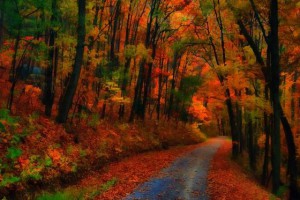 Foloi oak forest is a designated site under NATURA 2000 that dates back to ancient times. It’s the only flat forest in Greece situated on the boundaries between Elis, Arcadia and Achaia, at an altitude of 600meters. It covers a total surface of 218.000 acres and it consists mainly of broadleaf oaks.According to mythology, the forest was named after the Centaur Pholus, who gave roof to his friend, Hercules, on his way to locate the Erymanthian Boar. Pholus offered Hercules a divine wine which excited the rest of the Centaurs who attacked the two friends. During the battle, Pholus was injured by mistake from one of Hercules’ arrows. The hero decided then to name the forest Foloi after his friend.
Foloi oak forest is a designated site under NATURA 2000 that dates back to ancient times. It’s the only flat forest in Greece situated on the boundaries between Elis, Arcadia and Achaia, at an altitude of 600meters. It covers a total surface of 218.000 acres and it consists mainly of broadleaf oaks.According to mythology, the forest was named after the Centaur Pholus, who gave roof to his friend, Hercules, on his way to locate the Erymanthian Boar. Pholus offered Hercules a divine wine which excited the rest of the Centaurs who attacked the two friends. During the battle, Pholus was injured by mistake from one of Hercules’ arrows. The hero decided then to name the forest Foloi after his friend.
 In antiquity, the plateau of Foloi was covered by a dense plantation; namely, oaks, pines, kermes oaks, strawberry trees etc. as well as wild animals such as wolves, deer, boars, foxes, francolins, woodcocks, and numerous other species. The town of Akroria, Aasion, was situated on the west side of the plateau. The town was completely destroyed by Alarichos in 396 B.C. At the present, a true relic of the past, the oak forest of Filoi with its ancient trees starts in a distance of 15km from the village Lala. Wander into the magnificent forest and admire the breathtaking view to the plain of Alfeios and to the mountains.
In antiquity, the plateau of Foloi was covered by a dense plantation; namely, oaks, pines, kermes oaks, strawberry trees etc. as well as wild animals such as wolves, deer, boars, foxes, francolins, woodcocks, and numerous other species. The town of Akroria, Aasion, was situated on the west side of the plateau. The town was completely destroyed by Alarichos in 396 B.C. At the present, a true relic of the past, the oak forest of Filoi with its ancient trees starts in a distance of 15km from the village Lala. Wander into the magnificent forest and admire the breathtaking view to the plain of Alfeios and to the mountains.
Source: www.mythicalpeloponnese.gr
 The forest of Vassiliki is located at the southern part of the Taygetus mountain range, 8 km south of its summit, and has an expanse of approximately 11,000 stremmata. It is a relatively secluded forest, surrounded by summits. You can reach it from Eksochori and there is a road in the forest you can follow for 21 km.
The forest of Vassiliki is located at the southern part of the Taygetus mountain range, 8 km south of its summit, and has an expanse of approximately 11,000 stremmata. It is a relatively secluded forest, surrounded by summits. You can reach it from Eksochori and there is a road in the forest you can follow for 21 km.
Here you will mostly come across fir trees and black pines. During the Italian Occupation a great fire destroyed large expanses of the forest, which managed, however, to resurrect itself. Today one may see there trees as old as 300 years.
Source: www.mythicalpeloponnese.gr

